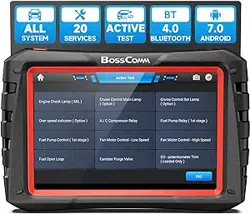Loading ...
Loading ...
Loading ...

6.4 ABS Bleeding
This function allows you to perform various bi-directional tests to check the operating conditions of Anti-lock Braking
System (ABS).
1. When the ABS contains air, the ABS bleeding function must be performed to bleed the brake system to restore ABS
brake sensitivity.
2. If the ABS computer, ABS pump, brake master cylinder, brake cylinder, brake line, or brake fluid is replaced, the ABS
bleeding function must be performed to bleed the ABS.
6.5 Tire Pressure Monitor System Reset
This function allows you to quickly look up the tire sensor IDs from the vehicle’s ECU, as well as to perform TPMS
replacement and sensor test.
1. After the tire pressure MIL turns on and maintenance is performed, the tire pressure resetting function must be
performed to reset tire pressure and turn off the tire pressure MIL.
2. Tire pressure resetting must be performed after maintenance is performed in the following cases: tire pressure is too
low, tire leaks, tire pressure monitoring device is replaced or installed, tire is replaced, tire pressure sensor is damaged,
and tire is replaced for the car with tire pressure monitoring function.
6.6 Gear Learning
The crankshaft position sensor learns crankshaft tooth machining tolerance and saves to the computer to more
accurately diagnose engine misfires.
If tooth learning is not performed for a car equipped with Delphi engine, the MIL turns on after the engine is started. The
diagnostic device detects the DTC P1336 'tooth not learned'. In this case, you must use the diagnostic device to perform
tooth learning for the car.
After tooth learning is successful, the MIL turns off. After the engine ECU, crankshaft position sensor, or crankshaft
flywheel is replaced, or the DTC 'tooth not learned' is present, tooth learning must be performed.
6.7 IMMO Service
An immobilizer is an anti-theft mechanism that prevents a vehicle’s engine from starting unless the correct ignition key or
other device is present.
Most new vehicles have an immobilizer as standard equipment. An important advantage of this system is that it doesn’t
require the car owner to activate it since it operates automatically.
An immobilizer is considered as providing much more effective anti-theft protection than an audible alarm alone. As an
anti-theft device, an immobilizer disables one of the systems needed to start a car’s engine, usually the ignition or the
fuel supply.
This is accomplished by radio frequency identification between a transponder in the ignition key and a device called a
radio frequency reader in the steering column. When the key is placed in the ignition, the transponder sends a signal with
a unique identification code to the reader, which relays it to a receiver in the vehicle’s computer control module.
If the code is correct, the computer allows the fuel supply and ignition systems to operate and start the car. If the code is
incorrect or absent, the computer disables the system, and the car will be unable to start until the correct key is placed in
the ignition.
To prevent the car being used by unauthorized keys, the anti-theft key matching function must be performed so that the
immobilizer control system on the car identifies and authorizes remote control keys to normally use the car.
When the ignition switch key, ignition switch, combined instrument panel, ECU, BCM, or remote control battery is
replaced, anti-theft key matching must be performed.
6.8 Injector Coding
Write injector actual code or rewrite code in the ECU to the injector code of the corresponding cylinder so as to more
accurately control or correct cylinder injection quantity.
After the ECU or injector is replaced, injector code of each cylinder must be confirmed or re-coded so that the cylinder
can better identify injectors to accurately control fuel injection.
6.9 Battery Maintenance System Reset
This function enables you to perform a resetting operation on the monitoring unit of vehicle battery, in which the original
low battery fault information will be cleared and battery matching will be done.
Loading ...
Loading ...
Loading ...
